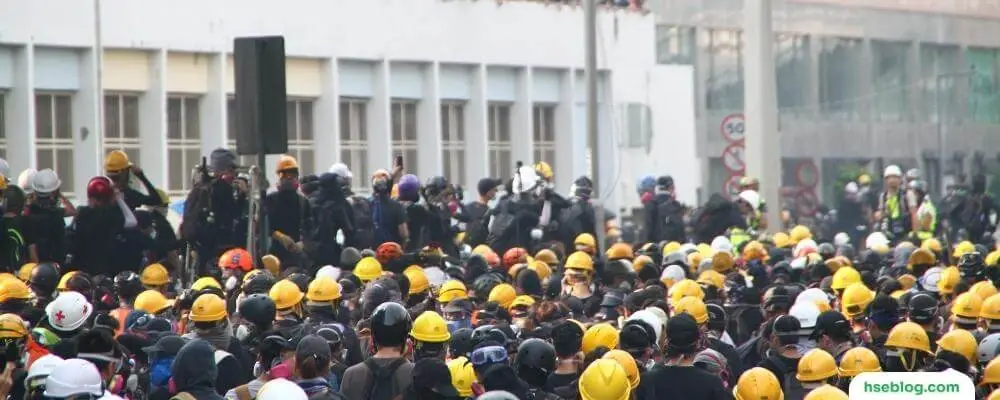Navigating the landscape of workplace safety can often seem like a complex endeavor. At the heart of this matrix, ensuring employees are safe and protected, stands the Occupational Safety and Health Administration (OSHA). OSHA is integral in setting and enforcing regulations to guarantee safe and healthy working conditions. However, as an employee, it’s crucial to understand that you are not just a passive recipient of these protections. OSHA also confers certain rights that allow you to actively preserve your safety and health in the workplace.
This blog post will delve into the core rights bestowed upon employees under OSHA regulations. We aim to break down these often technical and jargon-filled regulations into a more digestible format. From your right to receive training about hazards to your right to participate in OSHA inspections, each right will be explored in detail to help you grasp its implications fully.
Understanding your OSHA rights is not just about compliance; it’s about empowering yourself to actively participate in creating a safe, healthy, and productive working environment. Let’s dive into these rights and explore how to effectively exercise them to ensure workplace safety.
OSHA Workers Rights
You have the right to a safe workplace. OSHA requires employers to provide a workplace free of serious recognized hazards and comply with OSHA standards. Specifically, you have the right to:
1. Get Training From Your Employer
- It is your right to be trained by your employer about the chemicals you encounter in your work environment, how to stay safe around them, and to receive comprehensive information about them. The employer must provide a detailed hazard communication program, which includes labeling chemical containers, making material safety data sheets available, and providing training about the health impacts of the chemicals you interact with. It’s also their duty to share information about their precautions and the measures they can adopt to safeguard themselves against these hazards.
- The program should identify all hazardous chemicals present in each work area. It should define how employees will be informed about the risks associated with non-routine tasks, such as cleaning reactor vessels. Additionally, it should include the hazards related to unlabeled pipes and how other employers at a multi-employer worksite will be informed about the potential hazards their employees may face.
- You are entitled to receive training from your employer about various other health and safety risks and the standards your employer must adhere to. These areas include lockout/tagout, bloodborne pathogens, confined spaces, construction hazards, etc.

2. Request Information From Your Employer
- You have the right to ask your employer for information regarding health and safety hazards in your workplace. This includes details about the chemicals used, the results of tests performed to measure chemical, noise, and radiation levels, and the precautions you should take. Additionally, you should be informed about procedures to be followed in case of an incident or exposure to hazardous chemicals or toxic substances.
- You can request copies of all relevant standards, rules, regulations, and requirements your employer is expected to keep at the workplace. These documents outline safety guidelines, workplace regulations, and the rights and obligations of employees and employers.
- You can review the Log and Summary of Occupational Injuries and Illnesses, also known as the OSHA 300 log. This can be done at a reasonable time and manner, personally or via an authorized representative. This document tracks all work-related injuries and illnesses, offering a valuable overview of the workplace safety history.
- You can access pertinent exposure and medical records under OSHA’s regulations. These records can provide important information about your health and safety or workplace conditions.
- Employers must notify you about your medical and exposure records’ existence, location, and availability when you start your job and at least once a year after that. If you request these records, employers must provide them to you or your designated representative within 15 working days.
- Suppose an employer decides to cease operations, and no succeeding employer keeps these records. In that case, the employer must inform you about your right to access these records at least three months before the business closure.
- You have the right to observe any monitoring or measuring of toxic substances or harmful physical agents like noise in the workplace and to see the records of these measurements. If exposure levels exceed OSHA limits, the employer must inform you about corrective measures that will be taken. It’s important to note that the right to observe monitoring exists only where it is performed under a standard that provides employees with the right to observe.
3. Request Action From Your Employer To Correct Hazards Or Violations
You have the right to request your employer to rectify any unsafe conditions or hazards present in the workplace, regardless of whether these issues specifically breach any OSHA standards. This is a critical right as it empowers you to contribute to a safer working environment and advocate for your health and safety.
This broad provision includes not only obvious physical hazards but also potentially dangerous procedures, improper use of equipment, lack of adequate training, or other unsafe conditions. The idea here is that, as an employee, you are uniquely positioned to observe and identify hazards that may not be immediately apparent to others.
While making such requests, it’s advisable to maintain records for your own protection and future reference. Keep copies of any written requests or emails exchanged with your employer regarding these concerns. In case of verbal discussions, note down the key points of the conversation, the date, and the individuals involved. This can help provide evidence of your proactive steps toward promoting a safer workplace should any issues arise later.
4. File A Complaint With OSHA
You are entitled to submit a complaint to OSHA if you perceive severe workplace hazards or breaches of OSHA regulations within your workplace. The process of filing a complaint can be carried out in several ways. You can lodge it online, submit it in writing, or make it via telephone or fax. If you wish for an OSHA inspector to come and physically inspect your workplace, you should put your complaint in writing and deliver it to the nearest OSHA office. This action can lead to a more in-depth examination of the situation and potentially expedite remedial measures. This right to request an inspection is laid out in Section 8 of the OSH Act and clarified in 29 CFR 1903.11.
Moreover, you can request anonymity in your written complaint. If you do not wish for your employer to know that you were the one who filed the complaint, you can ask OSHA to keep your identity confidential. This provision, also part of Section 8 of the OSH Act, is designed to protect you from any potential retaliation or negative consequences arising from raising workplace safety concerns.
5. Be Involved In OSHA’s Inspection
You are entitled to have an authorized employee representative, such as a union representative, accompany the OSHA compliance officer throughout the inspection process. This right is stipulated in Section 8 of the OSH Act and further explained in 29 CFR 1903.8. The representative, who can be present with the OSHA compliance officer (a compliance safety and health officer, CSHO, or inspector), represents your interests.
Importantly, your employer does not have the right to choose this representative. If there’s no union or designated employee representative, the OSHA inspector must confidentially consult with a reasonable number of employees during the investigation to ensure a balanced perspective.
You are also entitled to engage directly with the compliance officer during the inspection process. You can answer their questions and provide them with information about workplace hazards, especially if no authorized employee representative is present during the inspection. This communication, as specified in Section 8 of the OSH Act, should be confidential and private, and it can take place whether or not a workers’ representative has been chosen.
You have the right to draw the officer’s attention to specific hazards, describe any injuries or near-miss incidents related to those hazards, and discuss any previous complaints about these risks. If the working conditions during the inspection are not typical, for example, if the equipment is shut down or other environmental changes are observed, you should inform the inspector. Your input is critical in ensuring that the inspector comprehensively understands the usual working conditions and potential safety issues in your workplace.

6. Find Out the Results Of An OSHA Inspection
You are entitled to learn about the findings from an OSHA inspection conducted at your workplace. If OSHA decides not to issue a citation after the inspection, you can request a review of this decision as outlined in CPL 2.115. This allows you to challenge any conclusions you believe might have overlooked potential violations or hazards.
An industrial hygienist may conduct a specialized OSHA health inspection when health hazards are suspected in your workplace. The role of an industrial hygienist involves identifying, evaluating, and working to control health hazards in the workplace. This specialized inspector might collect samples to measure levels of chemicals or other potentially harmful materials to ensure they are within acceptable limits.
OSHA will communicate with the employee representative about whether your employer is adhering to OSHA’s regulations. This includes sharing information about any measures your employer is taking to control health hazards and providing the results of any tests your employer may have conducted. This information is essential in helping you understand the safety conditions of your workplace and the actions your employer is taking to maintain a healthy working environment.
7. Get Involved In Any Meetings Or Hearings
You have the right to be actively involved in any meetings or hearings to address your employer’s objections to OSHA’s citations or proposed modifications for hazard corrections, also known as abatement deadlines.
Abatement deadlines are dates set by OSHA by which employers must correct and eliminate cited safety hazards. If your employer disputes the citation issued by OSHA or requests a change in the set abatement deadline, this can potentially impact your safety and wellbeing.
In these meetings or hearings, you are entitled to voice your concerns, provide your perspective, and obtain information about the potential impact of any changes to abatement deadlines or objections to citations. Your involvement ensures that your insights and concerns are considered when decisions related to workplace safety and compliance are being discussed.
This right affirms the importance of worker involvement in discussions that may impact their health and safety, allowing you to actively participate in the decision-making process related to resolving safety violations in your workplace.
8. File A Formal Appeal Of Deadlines For Correction Of Hazards
You have the right to challenge or appeal the deadlines that OSHA has set for your employer to rectify any safety violations identified in the issued citation. If you believe the granted time for hazard abatement is unnecessarily long and could potentially prolong your risk exposure, you can file an appeal.
To do this, you must submit a written appeal to the OSHA Area Director within 10 working days from the date your employer posts the notice seeking an extension for the hazard correction deadline. This is outlined in 29 CFR 1903.17. It is essential that your appeal is lodged within this period to ensure it is considered.
This right is important as it allows you as an employee, to actively participate in creating a safer workplace. By filing an appeal, you can push for quicker resolutions to hazardous conditions that might pose a risk to your health and safety, further enforcing the commitment to workplace safety and compliance with OSHA standards.

9. File A Discrimination Complaint
You have the right to file a discrimination complaint if you experience retaliation or discrimination for exercising your safety and health rights, as protected under Section 11(c) of the OSH Act.
This includes situations where you have raised concerns about workplace safety, requested an OSHA inspection, participated in an OSHA inspection, or reported a work-related injury or illness. It also applies if you refuse to work under conditions that pose an imminent danger of death or serious injury, and there isn’t enough time for OSHA to conduct an inspection.
If you believe you have been discriminated against or penalized for these actions, you can file a complaint with OSHA. However, it’s crucial to note that this complaint must be filed within 30 days of the alleged retaliation or discriminatory action.
This right protects you from any adverse consequences of asserting your safety and health rights. It enables you to actively participate in ensuring a safe and healthy work environment without fear of retaliation or discrimination. It is important to remember that while the OSH Act provides these protections, it does not explicitly guarantee the right to refuse work.
10. Request A Research Investigation On Possible Workplace Hazards
Suppose you are concerned about the potentially toxic effects of substances in your workplace. In that case, you can contact the National Institute for Occupational Safety and Health (NIOSH). You can request a health hazard evaluation to investigate your concerns further.
NIOSH is a federal agency responsible for conducting research and recommending prevention of work-related injury and illness. A health hazard evaluation from NIOSH involves investigating possible health risks in the workplace, which could be related to substances, conditions, or processes.
This right aims to ensure that you have access to expert resources to address and mitigate potential health risks in your workplace. It allows you to take an active role in identifying and reducing potential hazards that could impact your health and the health of your colleagues, leading to a safer work environment.
11. Provide Comments And Testimony To OSHA During Rulemaking
You can actively participate in OSHA’s rulemaking process by providing comments and testimony when new standards are being developed and proposed. The rulemaking process is critical to how OSHA develops and updates health and safety standards to protect workers.
During this process, OSHA often solicits public input on potential changes to regulations or the creation of new standards. This typically happens during a public comment period, where you can provide written feedback about the proposed rules. In some cases, OSHA might also hold public hearings where you can provide oral testimony about the proposed standards.
Your comments and testimonies can offer invaluable insights from a worker’s perspective. You can share your firsthand experiences, opinions, and suggestions regarding the proposed standards, helping shape more effective and realistic workplace health and safety regulations. This right gives you a voice in creating the rules designed to protect you on the job.
NOTE: States with OSHA-approved state plans (23 states and territories, plus two plans limited to public employees) provide at least the same rights and protections (and in some cases additional rights) to workers, although they may follow slightly different procedures.
What Information Must the Employee Provide?
Employees or their representatives must provide enough information for OSHA to determine that a hazard probably exists. To file a complaint, workers do not have to know whether a specific OSHA standard has been violated.
The following are examples of information useful to OSHA when receiving a complaint. It is unnecessary to have the answers to all these questions to file a complaint. The list is provided here as a guide to help you provide as much complete and accurate information as possible:
- Number of employees at the site and their exposure to the hazard: This information helps OSHA understand the potential scale of the issue. If a hazard is present, knowing how many employees might be affected is crucial for assessing its potential impact.
- How and when workers are exposed: This allows OSHA to understand the conditions and frequency of hazard exposure. This information can help OSHA determine the urgency and priority of addressing the issue.
- Work performed in the unsafe or unhealthy area: By understanding the type of work done in the hazardous area, OSHA can better grasp the nature of the potential risk and determine the appropriate safety standards.
- Type of equipment used and its condition: Equipment details and their condition can shed light on whether specific machinery or tools contribute to the hazard or if equipment malfunctions or poor maintenance are factors.
- Materials and/or chemicals used: Certain materials or chemicals can present health risks, so it’s important for OSHA to know if these are part of the workplace environment.
- Employee information or training regarding hazardous conditions: This helps OSHA assess if employees have been adequately trained to handle potential hazards, which is a requirement for employers.
- Process and/or operation involved: Details about the process or operation can help OSHA identify if specific procedures contribute to the risk.
- Types of work done nearby: This helps OSHA evaluate if nearby activities could contribute to the hazard or if workers in adjacent areas are at risk.
- Frequency and duration of employee exposure to the hazard: The frequency and duration of exposure can influence the severity of the risk to employees.
- Duration of the hazard’s existence: If a hazardous condition has existed for a long time, this could indicate a persistent safety issue that the employer has failed to address.
- Attempts made to correct the problem: Knowing if any efforts have been made to mitigate the hazard helps OSHA gauge the employer’s commitment to workplace safety.
- Shifts during which the hazard exists: Some hazards may not be constant but occur only during specific shifts or times, which is important for OSHA to know.
- Injury or illness as a result of the hazard: Information about any injuries or illnesses related to the hazard underscores the severity of the issue and the urgent need for action.
- “Near-miss” incidents: Information about incidents where an injury or illness almost occurred but was narrowly avoided can help OSHA understand potential risks that haven’t yet resulted in harm but still need attention.
Conclusion
In conclusion, understanding your rights as an employee under OSHA is crucial in fostering a safe and healthy working environment. These rights are not just legal entitlements but practical tools that empower you to actively safeguard your health and well-being at work. From your right to be trained about workplace hazards to your right to participate in OSHA inspections and even your right to refuse dangerous work, these all contribute to creating a culture of safety and responsibility. By leveraging these rights, you can play a pivotal role in ensuring workplace safety and health, ultimately making your workplace not just a place of work but a space of safety and care.

